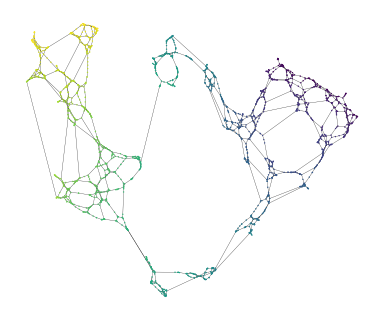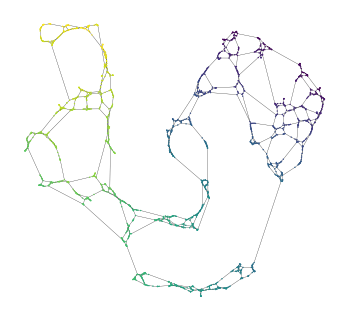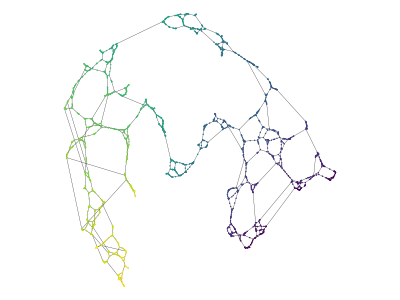Manifold Modelling with Minimum Spanning Trees
Dimensionality reduction (DR) algorithms typically assume the data they are given is uniformly sampled from some underlying manifold. When this is not the case, and there are observation-gaps along the manifold, these algorithms may fail to detect a single connected component. This repository presents two manifold approximation approaches for non-uniform sampled data that always construct a single connected component by building upon minimum spanning trees (MST).
Their main use-case is as input to dimensionality reduction algorithms for data visualization. This repository supports UMAP, where our manifold models improve projection and visualization quality at low number of neighbors. Additionally, our fast (approximate) minimum spanning tree construction algorithms can be used to speed up HDBSCAN (and other hierarchical) clustering.
Noisy Minimum Spanning Tree Union
The noisy minimum spanning tree union (n-MST) is inspired by Pathfinder networks that, with a specific parameter selection, yield the union set of all possible MSTs in a network (see, e.g., [1], [2]). We compute noisy MSTs to detect alternative connectivity at all distance scales for distances which may have few identically weighted connections.
We add Gaussian noise (mean=0) to every candidate edge. The noise parameter n is specified as a fraction of the points’ nearest neighbor distance and controls the Gaussian’s standard deviation. This formulation makes the noise scale with the data’s density to avoid adding more edges in dense regions than sparse regions, retaining a reasonably uniform manifold approximation graph.
import matplotlib.pyplot as plt
import matplotlib.collections as mc
from sklearn.datasets import make_swiss_roll
from multi_mst import NoisyMST
X, t = make_swiss_roll(n_samples=2000, noise=0.5, hole=True)
model = NoisyMST(num_neighbors=10, noise_fraction=1.0).fit(X)
projector = model.umap(repulsion_strength=1.0)
# Drawing the network
xs = projector.embedding_[:, 0]
ys = projector.embedding_[:, 1]
coo_matrix = projector.graph_.tocoo()
sources = coo_matrix.row
targets = coo_matrix.col
plt.figure(figsize=(4, 3))
plt.scatter(xs, ys, c=t, s=1, edgecolors="none", linewidth=0, cmap="viridis")
lc = mc.LineCollection(
list(zip(zip(xs[sources], ys[sources]), zip(xs[targets], ys[targets]))),
linewidth=0.2,
zorder=-1,
alpha=0.5,
color="k",
)
ax = plt.gca()
ax.add_collection(lc)
ax.set_aspect("equal")
plt.subplots_adjust(0, 0, 1, 1)
plt.axis("off")
plt.show()

k-Nearest Minimum Spanning Tree
The k-nearest Minimum Spanning Tree ($k$-MST) generalizes $k$-nearest neighbor networks ($k$-NN) to minimum spanning trees. It adds the $k$ shortest edges between components. Since data points start as distinct components, all $k$-NN edges are included in the kMST. This approach is faster than the noisy minimum spanning tree union because it runs the Boruvka algorithm only once.
To avoid creating shortcuts in the manifold, a distance threshold $\epsilon$ can be applied. The parameter is specified as a fraction of the shortest edge between components and provides an upper distance limit for the $2$-to-$k$ alternative edges.
import matplotlib.pyplot as plt
import matplotlib.collections as mc
from sklearn.datasets import make_swiss_roll
from multi_mst import KMST
X, t = make_swiss_roll(n_samples=2000, noise=0.5, hole=True)
model = KMST(num_neighbors=3, epsilon=2.0).fit(X)
projector = model.umap(repulsion_strength=1.0)
# Drawing the network
xs = projector.embedding_[:, 0]
ys = projector.embedding_[:, 1]
coo_matrix = projector.graph_.tocoo()
sources = coo_matrix.row
targets = coo_matrix.col
plt.figure(figsize=(4, 3))
plt.scatter(xs, ys, c=t, s=1, edgecolors="none", linewidth=0, cmap="viridis")
lc = mc.LineCollection(
list(zip(zip(xs[sources], ys[sources]), zip(xs[targets], ys[targets]))),
linewidth=0.2,
zorder=-1,
alpha=0.5,
color="k",
)
ax = plt.gca()
ax.add_collection(lc)
ax.set_aspect("equal")
plt.subplots_adjust(0, 0, 1, 1)
plt.axis("off")
plt.show()

Approximate k-MST
Computing $k$-MSTs using KDTrees can be expensive on some datasets. We provide a version of the algorithm based on Nearest Neighbor Descent for quicker approximations. We combined Boruvka’s algorithm with NNDescent to find neighbors that are not already connected in the MST being build. This variant supports all distance metrics implemented in pynndescent. Combined with fast_hdbscan’s cluster selection, it can greatly speed up computing (approximate) clusters on high dimensional data-sets!
import matplotlib.pyplot as plt
import matplotlib.collections as mc
from sklearn.datasets import make_swiss_roll
from multi_mst import KMSTDescent
X, t = make_swiss_roll(n_samples=2000, noise=0.5, hole=True)
model = KMSTDescent(num_neighbors=3, epsilon=2.0).fit(X)
projector = model.umap(repulsion_strength=1.0)
# Draw the network
xs = projector.embedding_[:, 0]
ys = projector.embedding_[:, 1]
coo_matrix = projector.graph_.tocoo()
sources = coo_matrix.row
targets = coo_matrix.col
plt.figure(figsize=(4, 3))
plt.scatter(xs, ys, c=t, s=1, edgecolors="none", linewidth=0, cmap="viridis")
lc = mc.LineCollection(
list(zip(zip(xs[sources], ys[sources]), zip(xs[targets], ys[targets]))),
linewidth=0.2,
zorder=-1,
alpha=0.5,
color="k",
)
ax = plt.gca()
ax.add_collection(lc)
ax.set_aspect("equal")
plt.subplots_adjust(0, 0, 1, 1)
plt.axis("off")
plt.show()

Supported Tasks
All three classes support several downstream tasks.
# Dimensionality reduction
# - Creates fitted UMAP or TSNE models from the computed manifold graph.
projector = model.umap(n_components=2) # or
projector = model.tsne(n_components=2)
# Graph layouts
# - Computes a 2D graph layout using (py)graphviz and networkx.
embedding = model.graphviz_layout(prog="sfdp")
# HDBSCAN or HBCC clusters
# - Creates a fitted HDBSCAN or HBCC model from the computed manifold graph.
# - Computes mutual-reachability from the model's number of neighbors.
clusterer = model.hdbscan(cluster_selection_method='leaf') # or
clusterer = model.hbcc(cluster_selection_method='leaf')
# Sub-cluster detectors
# - Ensures parameter and distance metric combinations are valid!
branch_detector = model.branch_detector(clusterer, min_cluster_size=5)
bc_detector = model.boundary_cluster_detector(clusterer, min_cluster_size=5)
# Accessors for the manifold graph
# - Mutual-reachability computed from the model's number of neighbors.
model.graph_ # CSR format, rows sorted by distance
model.mutual_reachability_graph_ # CSR format, rows sorted by mutual reachability
model.minimum_spanning_tree_ # Edgelist, unsorted
model.mutual_reachability_tree_ # Edgelist, unsorted
model.knn_neighbors_ # Adjacency lists for k-NN sorted by distance
model.knn_distances_ # Adjacency lists for k-NN sorted by distance
model.graph_neighbors_ # Adjacency lists for graph sorted by distance, -1 = missing
model.graph_distances_ # Adjacency lists for graph sorted by distance, inf = missing
The demonstration notebooks in ./notebooks provide more elaborate examples.
Installation Instructions
The multi_mst package can be installed from pypi:
pip install multi_mst
Acknowledgements
Most code—including the numba KDTree, disjoint set and boruvka MST construction implementation—is adapted from fast_hdbscan. The NNDescent implementation is adapted from pynndescent.
License
multi_mst uses the same license as fast_hdbscan: BSD (2-clause). See the LICENSE file for details.